Items filtered by date: September 2025
Systemic Sclerosis and Its Impact on Feet
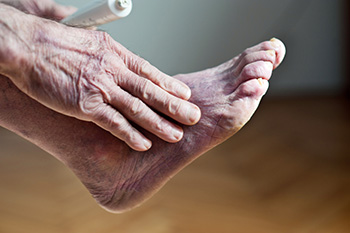
Color changes in the feet, such as redness, blue tones, or pale patches, can be an early indicator of autonomic involvement in systemic sclerosis, a rare autoimmune disorder. Systemic sclerosis affects blood flow by tightening blood vessels and altering circulation, which can cause noticeable color shifts in response to temperature or stress. Feet may appear blue due to reduced oxygen, red with increased blood flow, or pale when circulation is restricted. These color changes may also come with symptoms like numbness, tingling, or sensitivity to cold, signaling an underlying problem with the autonomic nervous system, which regulates involuntary functions, including blood vessel dilation. If you have this condition and it affects your feet, it is strongly suggested that you visit a podiatrist to manage symptoms and prevent complications. These foot specialists can assess circulation, suggest protective strategies for temperature changes, and work with other specialists to ensure proper blood flow and nerve function, ultimately helping to maintain foot health.
Some foot conditions may require additional professional care. If you have any concerns, contact Bryan Sullivan, DPM of Mississippi Foot Center . Our doctor can provide the care you need to keep you pain-free and on your feet.
Rare Foot Conditions
The majority of foot conditions are common and can be treated by a podiatrist. Standard diagnostic procedures are generally used to identify specific conditions and treatment can be rendered. A podiatrist also treats rare foot conditions which can be difficult to diagnose and may need extra attention and care.
There are many rare foot conditions that can affect children. Some of these can include:
- Freiberg’s disease
- Kohler’s disease
- Maffucci syndrome
Freiberg’s disease - This can be seen as a deterioration and flattening of a metatarsal bone that exists in the ball of the foot. It typically affects pre-teen and teenage girls, but can affect anyone at any age. Symptoms that can accompany this can be swelling, stiffness, and the patient may limp.
Kohler’s disease - This often targets the bone in the arch of the foot and affects younger boys. It can lead to an interruption of the blood supply which ultimately can lead to bone deterioration. The patient may limp or experience tenderness, swelling, and redness.
Maffucci syndrome - This affects the long bones in a child’s foot leading to the development of abnormal bone lesions. They are benign growths and typically develop in early childhood and the bones may be susceptible to breaking.
A podiatrist can properly diagnose and treat all types of rare foot conditions. If your child is affected by any of these symptoms or conditions, please don’t hesitate to call our office so the correct treatment method can begin.
If you have any questions, please feel free to contact our office located in Jackson, MS . We offer the newest diagnostic and treatment technologies for all your foot care needs.
Vascular Disease and Its Impact on the Lower Limbs
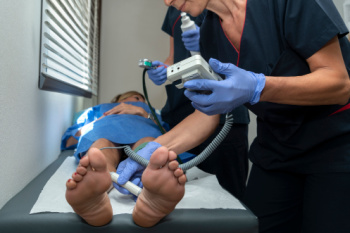
When circulation is compromised, the feet, ankles, and legs are often the first to show signs of trouble. Vascular disease restricts the flow of oxygen-rich blood, which can slow healing, weaken tissues, and increase the risk of infection. Even minor cuts, scrapes, or blisters may linger and become chronic wounds because the body is unable to deliver the nutrients needed for repair. Over time, this reduced circulation can also cause skin discoloration, cramping, and a heavy or tired feeling in the legs. People with diabetes or peripheral artery disease face even greater risks, as poor blood flow can lead to ulcers or more serious complications. Protecting the lower limbs means monitoring for changes, avoiding injuries, and seeking care quickly if a wound does not heal. It is suggested that you see a podiatrist for proper diagnosis, management, and treatment.
Vascular testing plays an important part in diagnosing disease like peripheral artery disease. If you have symptoms of peripheral artery disease, or diabetes, consult with Bryan Sullivan, DPM from Mississippi Foot Center . Our doctor will assess your condition and provide you with quality foot and ankle treatment.
What Is Vascular Testing?
Vascular testing checks for how well blood circulation is in the veins and arteries. This is most often done to determine and treat a patient for peripheral artery disease (PAD), stroke, and aneurysms. Podiatrists utilize vascular testing when a patient has symptoms of PAD or if they believe they might. If a patient has diabetes, a podiatrist may determine a vascular test to be prudent to check for poor blood circulation.
How Is it Conducted?
Most forms of vascular testing are non-invasive. Podiatrists will first conduct a visual inspection for any wounds, discoloration, and any abnormal signs prior to a vascular test.
The most common tests include:
- Ankle-Brachial Index (ABI) examination
- Doppler examination
- Pedal pulses
These tests are safe, painless, and easy to do. Once finished, the podiatrist can then provide a diagnosis and the best course for treatment.
If you have any questions please contact our office located in Jackson, MS . We offer the newest diagnostic and treatment technologies for all your foot and ankle needs.
It's Time for Beautiful Feet
Bunion Causes and Symptoms
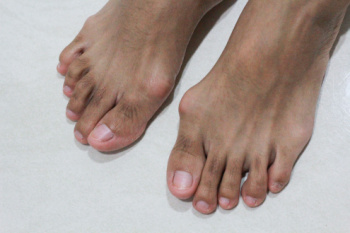
Bunions are a foot deformity that often develop gradually, leading to pain and changes in toe alignment. The most noticeable symptom of a bunion is a hard, bony bump on the side of the big toe that may become red, swollen, and tender from pressure inside shoes. As the bunion progresses, the big toe shifts inward toward the second toe, sometimes crossing over or under it, which can cause stiffness and difficulty in moving the joint. Pain at the base of the toe is common, especially when walking or standing for long periods. Bunions may also lead to irritation of the bursa, a small fluid-filled sac, resulting in bursitis, or displacement of the sesamoid bones under the big toe joint. Causes of bunions include inherited foot structure, arthritis, and frequent use of shoes that lack adequate support or have a narrow, pointed toe box, such as high heels or flip-flops. If you are experiencing pain from a bunion, it is suggested that you schedule an appointment with a podiatrist for an evaluation and appropriate treatment.
If you are suffering from bunion pain, contact Bryan Sullivan, DPM of Mississippi Foot Center . Our doctor can provide the care you need to keep you pain-free and on your feet.
What Is a Bunion?
Bunions are painful bony bumps that usually develop on the inside of the foot at the joint of the big toe. As the deformity increases over time, it may become painful to walk and wear shoes. Women are more likely to exacerbate existing bunions since they often wear tight, narrow shoes that shift their toes together. Bunion pain can be relieved by wearing wider shoes with enough room for the toes.
Causes
- Genetics – some people inherit feet that are more prone to bunion development
- Inflammatory Conditions - rheumatoid arthritis and polio may cause bunion development
Symptoms
- Redness and inflammation
- Pain and tenderness
- Callus or corns on the bump
- Restricted motion in the big toe
In order to diagnose your bunion, your podiatrist may ask about your medical history, symptoms, and general health. Your doctor might also order an x-ray to take a closer look at your feet. Nonsurgical treatment options include orthotics, padding, icing, changes in footwear, and medication. If nonsurgical treatments don’t alleviate your bunion pain, surgery may be necessary.
If you have any questions, please feel free to contact our office located in Jackson, MS . We offer the newest diagnostic and treatment technologies for all your foot care needs.
Foot Friction Blisters and Prevention
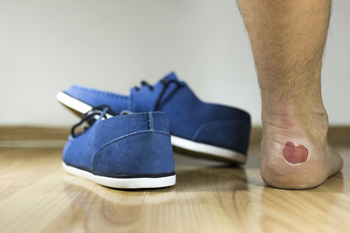
Foot friction blisters are small pockets of fluid that form when repetitive rubbing damages the top layer of the skin. They often appear on the toes, heels, or sides of the feet and can cause pain and discomfort. Risk factors include wearing ill-fitting shoes, excessive sweating, walking or running long distances, and new or stiff footwear. Prevention involves choosing shoes that fit properly, wearing moisture wicking socks, keeping feet dry, and using protective padding when needed. A podiatrist can provide safe and sterile treatment for painful or infected blisters and offer advice on footwear and skin care to reduce recurrence. If you struggle with frequent foot blisters, it is suggested that you contact a podiatrist who can offer relief and prevention strategies.
Blisters may appear as a single bubble or in a cluster. They can cause a lot of pain and may be filled with pus, blood, or watery serum. If your feet are hurting, contact Bryan Sullivan, DPM of Mississippi Foot Center . Our doctor can provide the care you need to keep you pain-free and on your feet.
Foot Blisters
Foot blisters are often the result of friction. This happens due to the constant rubbing from shoes, which can lead to pain.
What Are Foot Blisters?
A foot blister is a small fluid-filled pocket that forms on the upper-most layer of the skin. Blisters are filled with clear fluid and can lead to blood drainage or pus if the area becomes infected.
Symptoms
(Blister symptoms may vary depending on what is causing them)
- Bubble of skin filled with fluid
- Redness
- Moderate to severe pain
- Itching
Prevention & Treatment
In order to prevent blisters, you should be sure to wear comfortable shoes with socks that cushion your feet and absorb sweat. Breaking a blister open may increase your chances of developing an infection. However, if your blister breaks, you should wash the area with soap and water immediately and then apply a bandage to the affected area. If your blisters cause severe pain it is important that you call your podiatrist right away.
If you have any questions, please feel free to contact our office located in Jackson, MS . We offer the newest diagnostic and treatment technologies for all your foot care needs.
Essential Foot Care and Exercises for Older Adults
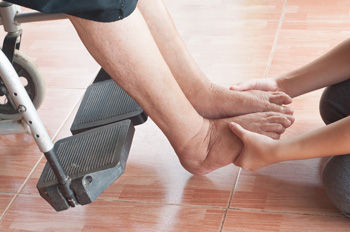
As people age, foot health becomes increasingly important for maintaining balance, mobility, and overall comfort. Common symptoms in elderly feet include stiffness, numbness, or instability. These are often caused by arthritis, reduced circulation, or muscle weakness. Feet may feel tired or unsteady, and daily activities can become more difficult. A podiatrist can assess changes in foot structure, gait, and strength, offering expert diagnosis and treatment options, such as orthotics, and footwear advice. Simple at-home exercises can also help. Towel scrunches strengthen the small foot muscles by pulling a towel with your toes. Arch lifts build strength and support in the midfoot, while a big toe stretch improves flexibility and alignment. These exercises promote better balance, reduce discomfort, and support joint health. To keep your feet strong and healthy as you age, it is suggested that you make an appointment with a podiatrist for personalized care and exercise guidance.
Proper foot care is something many older adults forget to consider. If you have any concerns about your feet and ankles, contact Bryan Sullivan, DPM from Mississippi Foot Center . Our doctor can provide the care you need to keep you pain-free and on your feet.
The Elderly and Their Feet
As we age we start to notice many changes in our body, but the elder population may not notice them right away. Medical conditions may prevent the elderly to take notice of their foot health right away. Poor vision is a lead contributor to not taking action for the elderly.
Common Conditions
- Neuropathy – can reduce feeling in the feet and can hide many life-threatening medical conditions.
- Reduced flexibility – prevents the ability of proper toenail trimming, and foot cleaning. If left untreated, it may lead to further medical issues.
- Foot sores – amongst the older population can be serious before they are discovered. Some of the problematic conditions they may face are:
- Gouging toenails affecting nearby toe
- Shoes that don’t fit properly
- Pressure sores
- Loss of circulation in legs & feet
- Edema & swelling of feet and ankles
Susceptible Infections
Diabetes and poor circulation can cause general loss of sensitivity over the years, turning a simple cut into a serious issue.
If you have any questions, please feel free to contact our office located in Jackson, MS . We offer the newest diagnostic and treatment technologies for all your foot care needs.

